Cascadia is a tile-laying game that takes players on a journey through the varied landscapes of the Pacific Northwest. Its captivating artwork and unique mechanics challenge players to build harmonious ecosystems by strategically placing habitat tiles and wildlife tokens. Designed by Randy Flynn, and published by Flatout Games and Pegasus Spiele, Cascadia combines puzzle-solving and resource management for an enjoyable experience suitable for gamers of all levels.
The game’s theme vividly portrays the natural wonders of the Pacific Northwest. Each habitat tile and wildlife token depicts lush forests, towering mountains, winding rivers, and serene lakes with remarkable detail. The artwork captures the beauty and diversity of the region’s ecosystems, fostering a sense of awe and admiration among players.
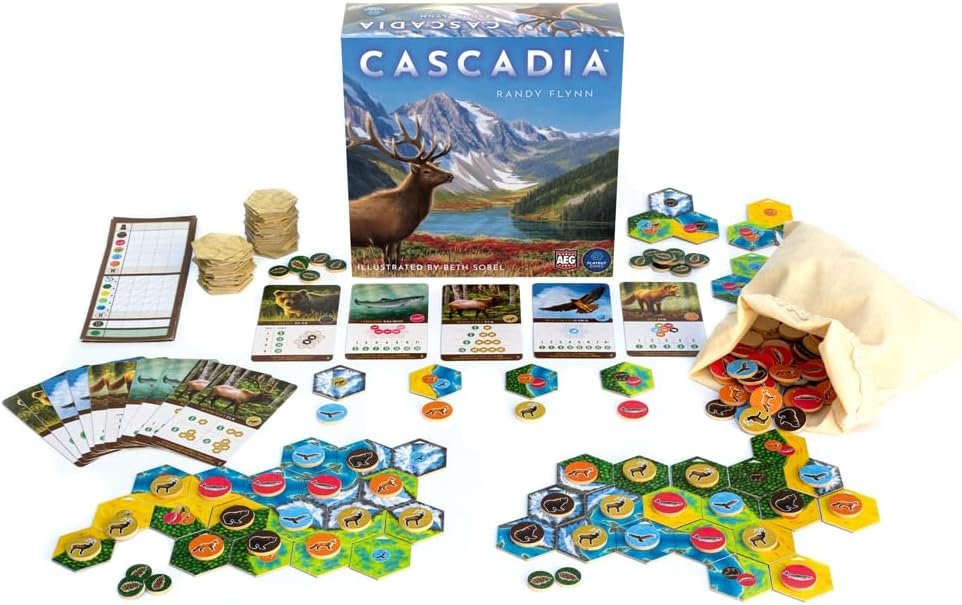
Mechanisms
Cascadia features a unique drafting system at its core, setting it apart from similar tile-laying games. In each turn, players pick a habitat tile and a wildlife token from a central pool. They must think critically about how these selections will shape their evolving landscape. Habitat tiles portray different terrains like forests, mountains, rivers, and lakes, each offering its own benefits for scoring.
On the flip side, wildlife tokens depict various animal species native to the area, from impressive elk and bears to elegant birds and fish. Placing these tokens strategically on compatible habitat tiles earns players points based on the diversity and size of their ecosystems.
This drafting method urges players to plan their moves in advance. Every choice carries weight, as early decisions can greatly affect the final landscape’s scoring potential and overall balance.
Age
Cascadia is recommended for players aged 10 and up, making it an excellent choice for family game nights or casual gatherings with friends. The game’s rules are straightforward, yet the strategic depth ensures an engaging experience for players of all ages and skill levels.
Player Count
Cascadia accommodates 1 to 4 players, offering a versatile gaming experience. Whether you’re playing solo, with a partner, ͏or in a small group, the ͏game’s͏ ͏mechanics scale seamlessly, ensuring an enjoyable and challenging experience for all.
Playtime
A ͏typical game of Cascadia lasts between 30 and͏ 45 minutes, making it an ideal choice for those seeking ͏a satisfying gaming experience without a significant time commitment.͏ The game’s brisk pace keeps players engaged throughout, while still allowing for thoughtful decision-making and strategic planning.
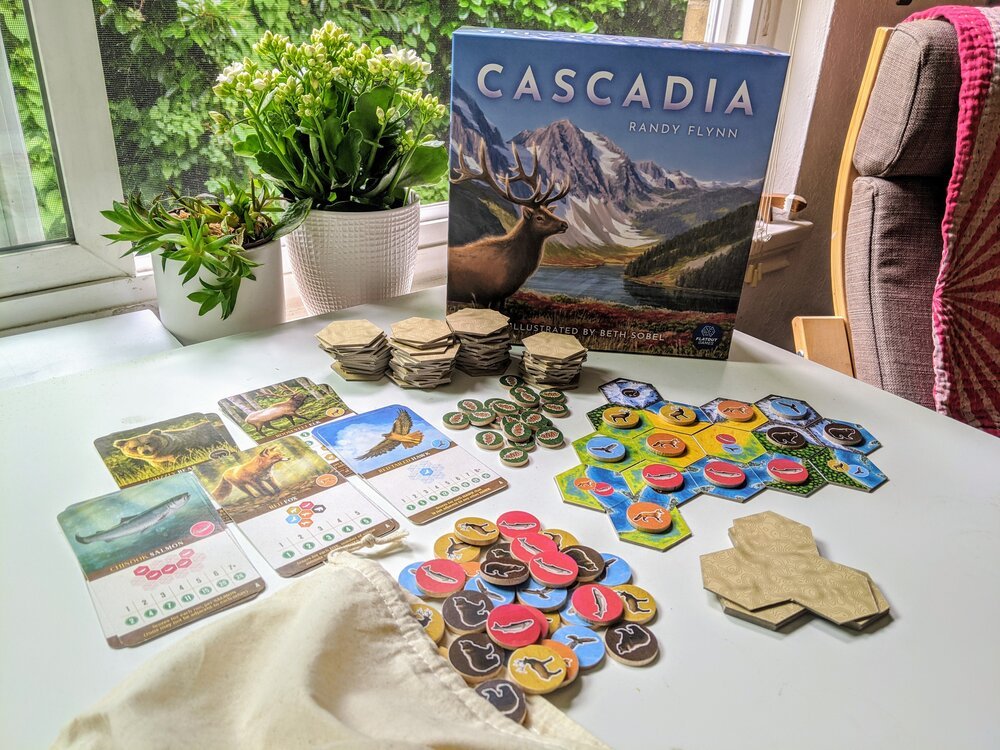
Gameplay Overview
On each turn, players choose one of four available habitat tile and animal token pairs, then carefully place them within their growing landscape. The terrain tiles feature a variety of environments – mountains, forests, prairies, wetlands, and rivers – and you’ll need to match the appropriate animal to each habitat type.
Optimizing your tile placement is key, as you’ll score points for creating contiguous regions of the same terrain. The animal tokens also have unique scoring conditions, ranging from points for the largest herds to bonuses for specific tile arrangements. Navigating the tradeoffs between layout optimization and meeting the needs of different species is the core strategic challenge.
An additional layer of depth emerges through the “nature token” mechanic. Placing an animal on a tile with a single habitat type grants you a bonus token that can be spent for additional actions or end-game points. Balancing the immediate benefits of these tokens against their long-term scoring potential adds an extra wrinkle to your decision-making.
Maintaining flexibility and adapting to the available tile and animal options is crucial, as you won’t be able to maximize every scoring opportunity. Making tough choices about your priorities is a key part of the Cascadia experience. The solo mode also provides an engaging challenge, allowing players to compete against a dynamic AI opponent.
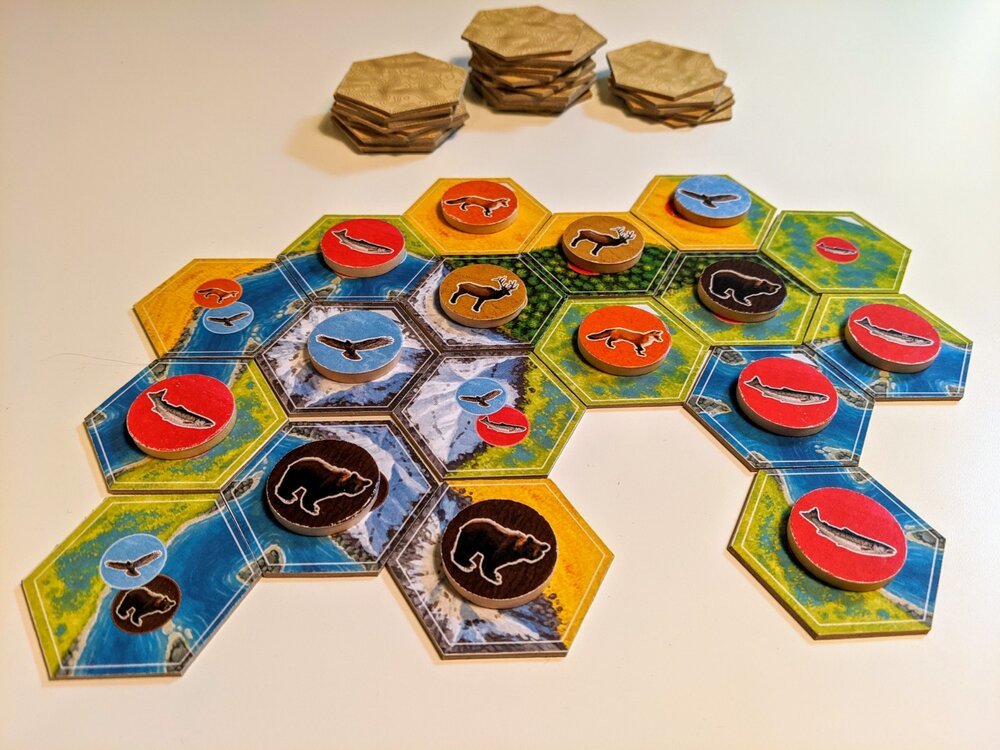
Replayability
Cascadia is highly replayable because of its interchangeable parts and adaptable setup. It comes with various habitat tiles and wildlife tokens, ensuring that each game feels fresh and unique. What’s more, the drafting mechanism adds an element of surprise, forcing players to adjust their strategies based on the choices available.
Additionally, Cascadia offers different ways to play, including solo modes and variants. The solo mode pits players against an automated opponent, challenging them to create the best ecosystem on their own. This provides a fun experience for those who like playing alone.
For families or those looking for a more relaxed gaming experience, Cascadia has a family variant. This version simplifies the objectives and scoring rules, making it easier for younger players or those who prefer a more laid-back approach. This flexibility ensures that Cascadia can be enjoyed by a wide range of people, regardless of their skill level or preferences.
Components
The͏ ͏components ͏of Cascadia are a true highlight͏, contributing significantly to the game’s overall appeal and immersive experience͏. The habitat ͏tiles are beautifully illustrated, depicting vibrant landscapes that capture the essence of the Pacific Northwest region. From the towering͏ peaks͏ of͏ the Cascade Mountains to the lush forests and winding rivers, each tile is͏ a work of art, inviting players to lose themselves in the game’s natural wonders.
The wildlife tokens are equally stunning, featuring detailed representations of various animal ͏species native to the region. The attention to detail in these tokens is͏ remarkable͏, capturing the unique characteristics and behaviors of each creature, from the majestic elk to the graceful heron.
The quality of the components is exceptional, with sturdy ͏cardboard tiles and durable tokens that ensure a long-lasting gaming experience. The tiles have a satisfying weight and texture, while ͏the tokens are made of high-quality materials that resist wear and tear.
Beyond their͏ visual appeal and͏ durability, the components of Cascadia are thoughtfully͏ designed to enhance the gameplay experience.͏ The habitat ͏tiles feature clear iconography and scoring information, making it easy for players to quickly assess their options ͏and plan their moves͏. ͏The wildlife tokens, too, are ͏color-coded and marked with symbols that correspond to their compatible habitats͏, streamlining the gameplay and reducing the need for constant rulebook referencing.
Strategy and Depth
While the rules of Cascadia are relatively straightforward, the game offers a surprising depth of strategic considerations. Players must carefully evaluate the available habitat tiles and wildlife tokens, considering how their choices will impact their scoring potential and the overall harmony of their landscape.
Spatial awareness and resource management are key elements of the game’s strategy. Players must plan ahead, anticipating how their tile placements will create or disrupt contiguous areas, and how their wildlife token choices will contribute to the diversity of their ecosystems.
One of the most challenging aspects of Cascadia is the need to balance short-term and long-term goals. While it may be tempting to focus on creating large contiguous areas for immediate points, players must also consider the long-term implications of their actions. Failing to diversify their wildlife populations or neglecting certain habitat types can severely limit their scoring potential in the later stages of the game.
Additionally, players must remain adaptable, as the drafting mechanism introduces an element of unpredictability. Successful players will be able to pivot their strategies based on the available options, capitalizing on opportunities and mitigating potential setbacks.
Accessibility and Learning Curve
Cascadia stands out for how easy it is to get into, making it a great choice for players of all skill levels. The rulebook is written well, and it’s easy to understand, with clear explanations and helpful examples that make it easy for new players to learn.
Plus, the game’s mechanics are simple and easy to pick up, so players can understand the main ideas quickly and focus on making strategic decisions. This makes Cascadia perfect for family game nights or casual get-togethers with friends who might have different levels of experience with games.
One of the game’s strengths is that it can appeal to different types of players. Experienced gamers will like the strategic depth and the need for careful planning, while casual players can enjoy the game’s nice look and the feeling of making beautiful landscapes.
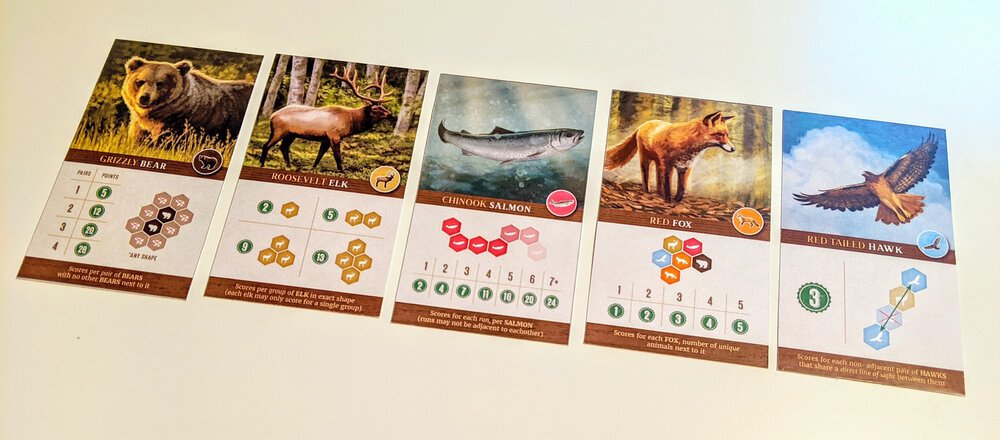
Comparison and Similar Games
While Cascadia shares ͏some similarities with other tile-laying games, it stands out with its unique drafting mechanism and emphasis on͏ ecosystem creation. Games like Carcassonne and Kingdomino, while͏ enjoyable, lack the depth and strategic considerations͏ that Cascadia offers.
Cascadia’s ͏closest comparison might be to Calico, another tile-laying game with a focus on pattern-building and resource management. However, Cascadia’s drafting mechanic and the added layer of wildlife token placement set it apart, offering a distinct and engaging gaming experience.
Another game that shares some similarities with Cascadia is ͏Photosynthesis, which also revolves around building and expanding ecosystems. However, ͏Photosynthesis has a more abstract and strategic approach, ͏while Cascadia offers a͏ more immersive and visually appealing experience.
Final Verdict
Cascadia succeeds admirably in what it sets out to achieve: providing a versatile and enjoyable gaming experience suitable for a wide range of players. Its ease of teaching and engaging nature-themed puzzle mechanics make it accessible and appealing to both newer gamers and seasoned veterans alike. The game’s stunning artwork, particularly by Beth Sobel, elevates the experience and adds to the overall immersion.
However, while Cascadia may excel in its accessibility and thematic appeal, it falls short of delivering the groundbreaking or deeply engaging experience that some players might expect given the hype surrounding it. Its mechanics, while solid, may feel somewhat familiar to experienced gamers, and its strategic depth may not satisfy those seeking more intense or competitive gameplay.
Ultimately, Cascadia is a well-crafted and enjoyable game that offers a pleasant gaming experience, particularly for those looking for a lighter, more relaxing gaming session. Its blend of accessible gameplay, beautiful artwork, and thematic immersion make it a worthy addition to any collection, especially for families or casual gaming groups. However, if you’re expecting a revolutionary gaming experience or intense strategic depth, it may not fully meet those expectations. Approach Cascadia with an appreciation for its strengths as a charming and accessible game, and you’re likely to find enjoyment within its Pacific Northwest wilderness.
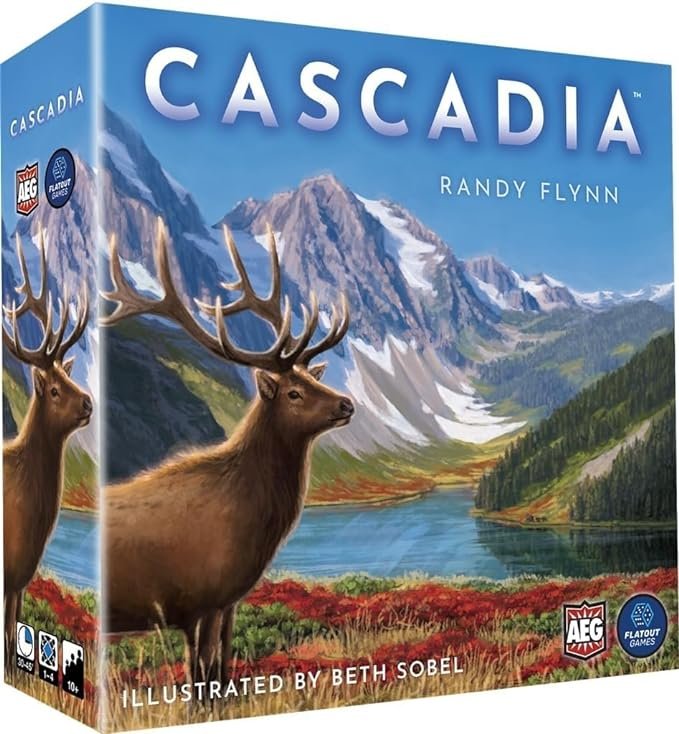
At no extra cost to you, The Board Game Site may receive revenue from affiliate and advertising partnerships for sharing this content and from purchases through links.






